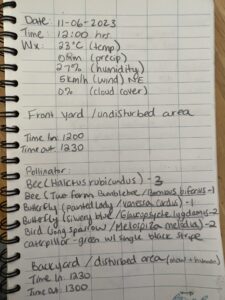- I plan to study pollinator abundance in my yard for this research project.
-
During my observations of pollinator abundance in my yard, I noticed a difference between undisturbed and disturbed areas. In order to explore this phenomenon, I conducted an assessment along a gradient of comparable sizes, including an area with minimal disturbance, an area subjected to only lawn mowing, and an area experiencing disturbances from lawn mowing as well as human and dog activity.
The findings revealed a higher abundance of pollinators in the undisturbed area compared to the disturbed areas. Moreover, the area with the highest level of disturbance due to human and dog activity exhibited the lowest number of pollinators. Additionally, I observed a greater presence of plant diversity in the undisturbed area.
I have included my field notes and photos of the disturbed and undisturbed areas for reference below.
3.
Hypothesis: If lawns are left undisturbed, then a higher presence of pollinators will be observed.
Prediction: If the hypothesis holds true, indicating that undisturbed lawns foster abundant pollinator populations, I expect to observe a greater number of pollinators and a higher diversity of plant species in the undisturbed area compared to the disturbed area.
4.
Response Variable: Number of pollinators (categorical)
Explanatory variable: Presence / Absence of disturbance (categorical)
Both of these variables are categorical and as a result would fall under a tabular experimental design.



Disturbed Area 
Undisturbed Area
ok I see this has grown a bit to include area of disturbance…
that introduces a complexity that you don’t need necessarily if you are looking at undisturbed vs mowed
As suggested earlier, you might consider mowing the day before observations are made in order to standardize the ‘mowed’ area
If you are using lawn disturbance as predictor, you technically have two treatments (undisturbed and disturbed) but three areas or plots – one undistrubed, one mowed, and one disturbed by humans. so you have to be careful comparing disturbed vs undisturbed, because the samples are not equal now
now is it ‘higher diversity of plant species’ (and were these counted via plot or other) or is it the fact that there are fewer flowering plants in the disturbed areas (would it matter if the undisturbed was covered in dandelions alone?)
I think the project started out a little more cleanly or straight-forward than it has morphed into – more questions are being asked (which is good!) and/but these questions could be moved to future studies – for example, future studies might look at the diversity of plant species, but this study did not measure diversity in its methods
Nancy Elliot